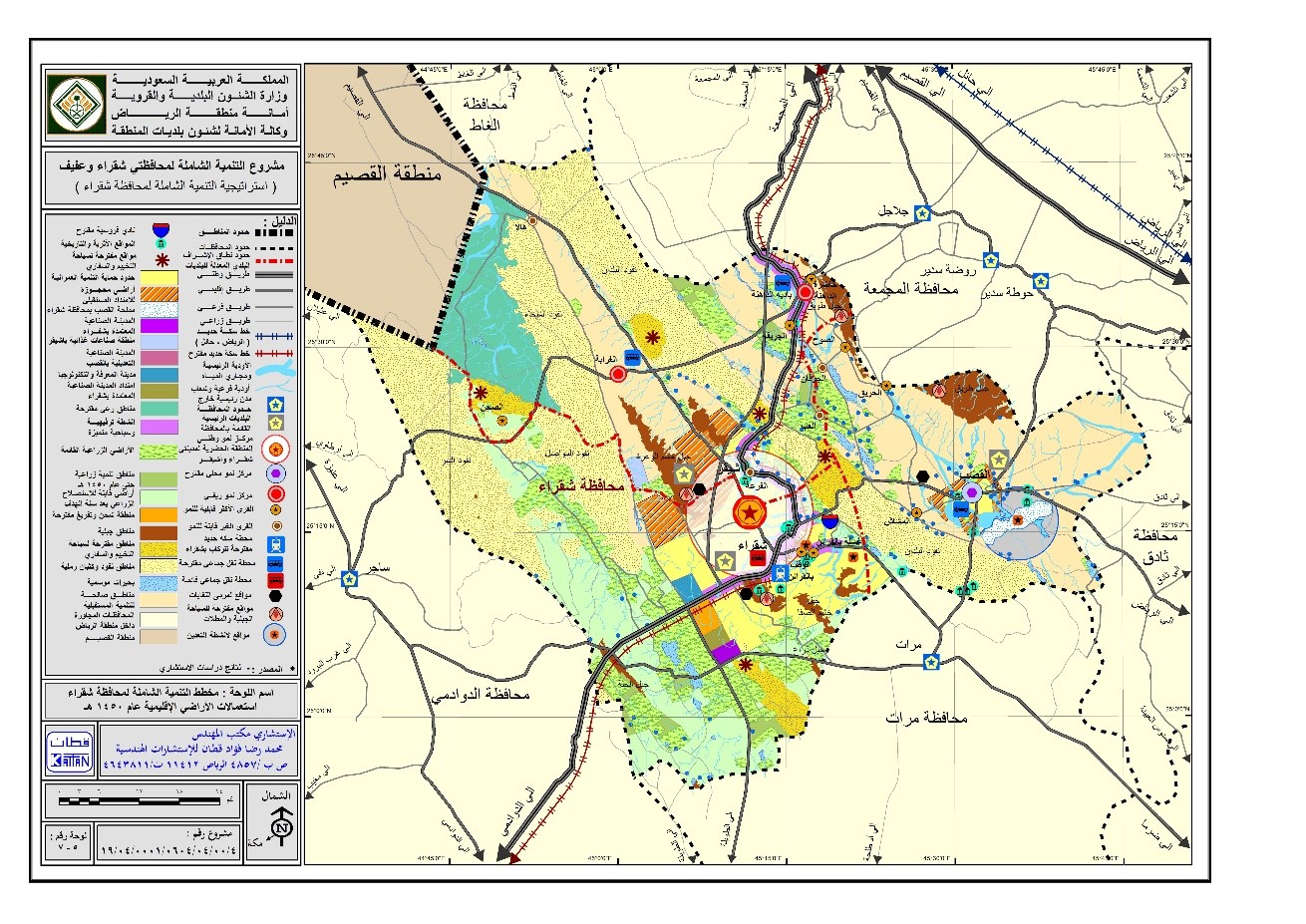| Preparation fields for comprehensive development plans for the governorates | |
|---|---|
| Location | Riyadh Governorates - Dawadmi, Shaqra and Afif Governorates |
| Client | Riyadh Municipality Secretariat for Municipalities and Provinces (Dawadmi - Shaqra - Afif) affairs |
| Duration | 24 months for Dawadmi + 24 months for Shaqra and Afif together |
| Type of work | Preparing comprehensive development plans for the governorates of Dawadmi, Shaqraa and Afif until 1450 H |

A brief overview of the work
Comprehensive development strategies were prepared for the governorates (Dawadmi - Shaqra - Afif) in the light of the study and analysis of the current situation of each governorate separately. The impact of national, regional and local development strategies on these governorates was studied, the most important of these strategies are: the five-year plans for social and economic development in the Kingdom prepared by Ministry of Economy and Planning every five years in order to guide the development processes, the national urban strategy of the Kingdom prepared by the Ministry of Municipal and Rural Affairs and approved by the Council of Ministers in 1421 H, and the strategy of rural development prepared within the framework of the National Urban Strategy, the Urban Development Strategy for Riyadh Region prepared by the Ministry of Municipal and Rural Affairs in 1424 H, the Regional Plan for Riyadh Region prepared by the Higher Commission for the Development of Riyadh City in conjunction with the Riyadh Region Secretariat approved in 1434 H, and the Tourism Development Strategy for Riyadh Region prepared by the Supreme Commission for Tourism, in addition to the urban scale studies and structural plans prepared by the Ministry for the cities of the governorates (Dawadmi - Shaqra - Afif) in addition to the cities affiliated to each governorate. The problems and limitations of development have been identified in all sectors, the most important of which are organizational, administrative, natural, environmental, urban, demographic, social and economic problems and limitations, in addition to the problems and limitations of public services, road networks and infrastructure networks. The opportunities and potentials of development that can contribute to the economic, social and urban development in the governorates (Dawadmi - Shaqra - Afif) were identified during the planning period ending in 1450 H, the most important of which are natural, environmental, urban, social and economic opportunities and potentials in addition to the opportunities and potentials of public services, roads network and infrastructure networks. The validity of the lands of each governorate for future development was studied through a set of constraints and development criteria to determine the lands suitable for future development at each governorate level. In light of all the above, a quadrilateral analysis was conducted, which is the real criterion for studying the internal and external influences of the governorate, where the strengths and weaknesses were identified and the potential and risk areas were identified for all development sectors in these governorates. Based on the above, the future vision that contributes to the development of these governorates and activating the role of each governorate and its urban and rural communities was defined within the general framework included in the general directions of the Kingdom's national urban strategy and regional studies. Based on the above, the future vision of the governorates was formulated, which aims primarily at achieving sustainable development of these governorates, ensuring a practical and viable strategy developed by all concerned parties to ensure adherence to the proposed future vision of each governorate and the proper utilization of available natural resources, and determining the necessary financial resources required to finance the implementation processes, in addition to the detailed outputs of the study that contribute to the development and management of the construction of these governorates. The general formula for the future vision of the provinces (Dawadmi - Shaqra - Afif) was suggested. In the light of that vision, the development goals are set to be practical, realistic and measurable to be achieved within a specific time frame, and then translated into short-term, medium-term and long-term goals, where achieving short-term (s) goals achieve medium-term goals and medium-term goals achieve long-term goals through to achieving the overall vision. These objectives were formulated on the developmental sectors entrusted to the study (Construction - Population - Economy - Public Services - Infrastructure), and a set of executive policies were proposed that achieve short, medium and long-term goals, showing the possibility of activating these goals and represents the executive mechanism for the implementation of the comprehensive development strategy for the governorates of (Dawadmi - Shaqra - Afif). Three scenarios have been proposed for the comprehensive development strategy for each governorate. The first scenario is based on the concept of concentrated development, which achieves the continuation of the current pattern of development in the three governorates under study in terms of the continued concentration of economic, social and urban development in the cities (Dawadmi - Shaqra - Afif) to benefit from the advantages, potentials and economic savings achieved for economic activities, in terms of the availability of public services and infrastructure networks in these cities in particular. The second scenario is based on the concept of a pervasive development in a concentrated manner that achieves spreading development in specific and carefully selected communities in a balanced manner over the entire geographical area of the three governorates to take advantage of all available natural, environmental, economic and human resources, and to achieve equitable distribution of development opportunities, reduce the apparent disparity between urban and rural areas, and reduce the attraction of cities (Dawadmi - Shaqra - Afif) for the population, services and economic activities. The third scenario is based on the concept of pivotal development in order to spread development in these governorates in the form of hubs for the distribution of urban communities and economic activities associated with the main road network at the level of each governorate, in order to achieve justice in the distribution of development opportunities and in line with the potential of development axes. The three scenarios were studied in terms of population distribution, future population projections, structure of economic activities, classification of urban communities and their functions, the main axes of transportation, and identifying the advantages and disadvantages of each scenario. The three scenarios of the comprehensive development strategy were evaluated based on a set of evaluation criteria that meet the objectives of urban, social, human and economic development, the objectives of developing the regional road and transport network and the objective of achieving the efficiency and effectiveness of the planning process, where a relative weight was given to each criterion. Through the process of evaluating the three scenarios, it became clear that the second scenario is the best. Accordingly, comprehensive development plans for the governorates of Dawadmi, Shaqra and Afif were prepared until 1450 H based on the proposals of this scenario. The philosophy of comprehensive development strategies for the governorates of (Dawadmi, Shaqra and Afif) was based on focusing on dividing these governorates into development zones and creating development axes within each governorate in accordance with the potentials and resources of the different regions within each governorate, defining the structure of the regional urban system and the functional role of the urban communities. Which can contribute to development. The regional and sectoral development strategies for these governorates have been formulated taking into account the general objectives of the strategies for the protection of natural and environmental resources in each governorate separately and defining the method of achieving these strategies through defining the method of protecting environmental areas, reducing environmental pollution, protecting valleys and sheebs, preserving productive agricultural lands and protecting areas of sand-dunes and Nafud. A strategy for the distribution of urban communities and their functions was based on the creation of a regional urban system to accommodate future development work and achieve balanced development and integration between urban and rural areas. The function of the proposed regional, local and rural growth centers and the identification of public services, economic activities and the functions these centers can provide. The strategy for the development of urban communities was based on the redistribution of the scope of municipal supervision because there are some villages served by municipalities located more than (50 km) away, although there are other municipalities very close to these villages. This is in addition to activating the functional classification of urban communities by redistributing public services according to their different levels, and providing economic activities, investment opportunities and jobs in a way that contributes to each communities' functional role in the framework of the comprehensive development strategy of the governorates (Dawadmi - Shaqra - Afif). In addition, a strategy for the development of urban and rural communities in these governorates will be established, through which the development objectives, development policies suggestions, programs, projects and detailed studies that can be implemented to achieve the proposed development policies for these communities are identified. The population development strategy dealt with the current and projected annual population growth rates in the governorates of the study, its main cities and future population projections till the year 1450 H, taking into account achieving population and urban balance to reduce development inequalities within each governorate and direct development efforts towards improving the conditions of major cities in each governorate to reduce migration to the cities of (Dawadmi, Shaqra, Afif) or major cities outside these governorates, by improving the level of public services, supporting utilities networks, improving the standard of living of the population and providing jobs suitable for their abilities and capabilities. The economic development strategy also clarified the objectives of economic development in the governorates (Dawadmi - Shaqra - Afif) and the method of achieving these strategies through the development of strategies for the development of various development areas, the most important of which are agricultural, industrial, archaeological and historical areas, quarries, grazing areas, mountain areas and valleys sources, by defining targets of development of each region and policies that achieve these objectives, programs, projects and detailed studies that can achieve these policies. The strategy of developing regional road and transport networks clarified the general objectives of developing roads and transport networks in the governorates of (Dawadmi - Shaqra - Afif) and the functional classification of the existing and proposed roads network and the locations of the proposed public transport stations in each governorate, as well as the distribution of public transport by buses to serve urban communities and the importance of benefiting from the approved railway lines passing through these governorates. In light of the above-mentioned sectoral strategies, the proposed land uses for each governorate were identified and distributed which were formulated in the proposed comprehensive development plans for the governorates (Dawadmi - Shaqra - Afif) until 1450 H. These plans aim to develop a long-term vision of the development trends in the governorates under study based on the distinctive characteristics of the development zones and their resources, in order to achieve the optimal exploitation of these resources within the framework of sustainable development, and commensurate with the function of each region and achieve social and economic growth at the level of each governorate. Through these plans, the spatial distribution of regional land use elements such as agricultural, mountainous and environmental areas, natural grazing areas, dune areas, valleys, flood streams, mining areas, quarries, main road network tracks, and proposed economic activities sites up to 1450 H was determined.
